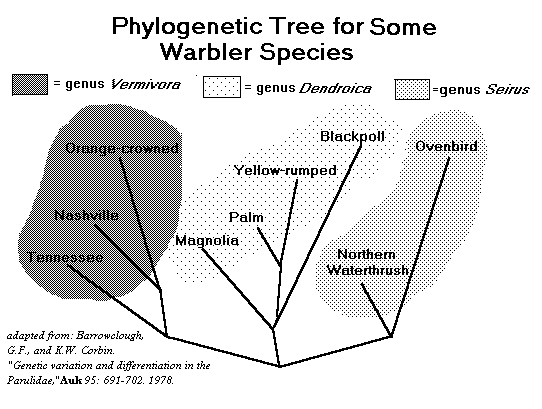
Plant and animal species have not evolved to neatly fit into our boxlike taxonomic categories. Nature has made absolutely no effort to make her organisms fit mankind's rigid, artificial concepts.
In fact, evolving life proceeds more or less like a tree that starts as a single sprout, and branches, and then the branches branch, and so forth, with the branches growing at different rates, and branching with various degrees of vigor. Sometimes "leaves" at the tips of these tree-of-life branches (the species) are well defined and fully formed, but sometimes they're not.

Scientists often try to reconstruct evolutionary trees with the idea of portraying graphically how today's species evolved. The more technical name for "evolutionary tree" is "phylogenetic tree." The sample tree shown above portrays how certain warblers are related to one another. From this tree we can guess that at one time there was one general, warbler-like species. This evolved into at least three different species. Eventually each of these species further diversified into the genera today known as Vermivora, Dendroica, and Seirus. These genera, in turn, have fragmented into numerous species recognizable today. The genus Dendroica includes over twenty-five species.
In the past, biologists working on such trees had to content themselves with characteristics they could plainly see. The more alike organisms looked, the more closely related they were assumed to be. That's often really the way it works, but also this approach has lead to some pretty serious errors. Nowadays, new techniques give us ever clearer ideas of what the real trees should look like.
For instance, in a process known as DNA sequencing, today we can determine how much genetic material different species have in common. If a large percentage of the genetic code, or DNA, of two species or two groups of species is identical, then they are considered to be closely related. If only a small percentage is identical, their relationship is distant.